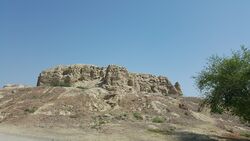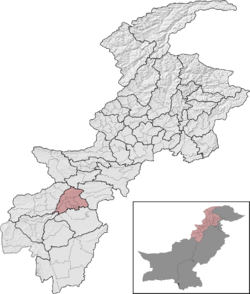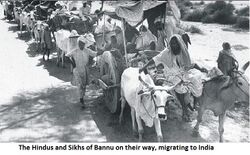ضلع بنو
ضلع بنو
ضلع بنوں بنو ولسوالۍ | |
|---|---|
 Mound at Akra | |
 Bannu District (red) in Khyber Pakhtunkhwa | |
| Country | |
| الإقليم | |
| القسم | بنو |
| Headquarters | Bannu |
| الحكومة | |
| • النوع | District Administration |
| • Deputy Commissioner | Mohammad Khan Bangash |
| • Member of National Assambley | Mualana Nasim Ali Shah |
| • District Health Officer | N/A |
| المساحة | |
| • Total | 1٬972 كم² (761 ميل²) |
| التعداد | |
| • Total | 1٬167٬892 |
| • الكثافة | 590/km2 (1٬500/sq mi) |
| منطقة التوقيت | UTC+5 (PST) |
| Number of Tehsils | 4 |
| الموقع الإلكتروني | bannu |
ضلع بنو ( Bannu District ؛ Pashto: بنو ولسوالۍ, أردو: ضلع بنوں) is a district in the Bannu Division of the Khyber Pakhtunkhwa province of Pakistan. Its status as a district was formally recorded in 1861 during the British Raj.[2][3]
This district constitutes one of the 26 districts that collectively form the Khyber Pakhtunkhwa province. It borders North Waziristan to the northwest, Karak to the northeast, Lakki Marwat and Bettani to the southeast, and South Waziristan to the southwest. It is represented in the provincial assembly by four MPAs.[3]
Cloth weaving, sugar mills and the manufacturing of cotton fabrics, machinery and equipment are the major industries in Bannu. It is also known for its weekly Jumma fair. The district forms a basin drained by the Kurram and Gambila (or Tochi) rivers, which originate in the hills of Waziristan. Although Bannu is surrounded by rugged and dry mountains, it is a fertile place, and early English visitors had been known to refer to it as a "paradise" – see the description by Edwardes quoted by Thornton.[2][3]
السمات الطبيعية
The district forms a basin drained by the Kurram River , Gambila River and Tochi river[2] which originate in the hills of Waziristan. Extending its reach to the base of the frontier hills, the Bannu Valley unfolds as an asymmetrical oval, spanning 60 miles (97 km) from north to south and 40 miles (64 km) from east to west.[4]
التاريخ
The history of Bannu goes back to prehistoric times due to its strategic location. Notably, Sheri Khan Tarakai is an ancient settlement site located in the Bannu District. Here, remnants bear witness to the presence of the most ancient village settlement within the Bannu region. This site witnessed occupation from the late fifth century to the early third millennium BC.[5]
The sacred texts of Zend Avesta and Vendidad mentions Varəna, the Avestan predecessor of the name for Bannu, as one of the sixteen most beautiful and perfect lands created by Ahura Mazda.[6] Bannu is the homeland and birthplace of Fereydun;[7]
Malik Dilasa Khan had also fought a successful battle against the sikh empire.[8] in which he killed one of the prominent Sikh Military commander Jai Singh Atariwala in the Battle of Bannu.[9]
العصر البريطاني (1861–1947)
After the British annexation of Punjab, then including parts of the North-West Frontier Province (NWFP), the valley was administered by Herbert Edwardes.[4] As a result of his administration, the region became a source of strong support[مطلوب توضيح], during the Indian Rebellion of 1857. Although the valley itself was peaceful, it was subject to incursions from the Waziri tribes of the Tochi Valley and the neighbouring hills. The primary export of the region was wheat, Salt and alum were also quarried at Kalabagh.[4]
As of 1911, the Indus had no bridges within the district, but was navigable for local boats throughout its course of 76 mi (122 km).[4]

جرگا بنو (1947)
On 21 June 1947 in Bannu, a jirga was held by Pashtun leaders including Bacha Khan, his brother Chief Minister Dr Khan Sahib, the Khudai Khidmatgars, members of the Provincial Assembly, Mirzali Khan (Faqir of Ipi), and other tribal chiefs, just seven weeks before the Partition of India. The jirga declared the Bannu Resolution, which demanded that the Pashtuns be given a choice to have an independent state of Pashtunistan composing all Pashtun territories of British India, instead of being made to join either India or Pakistan. However, the British Raj refused to comply with the demand of this resolution, in response to which the Khudai Khidmatgars boycotted the 1947 North-West Frontier Province referendum for merging the province into Pakistan.[10][11]
Pashtun National Jirga (2022)
On 11-14 March 2022, the Pashtun National Jirga was held at Mirakhel in Bannu District in order to defend the rights of the Pashtun people in the country. The critical issues which were faced by the Pashtuns were discussed during the jirga in a bid to suggest solutions to them.[12][13]
التقسيمات الإدارية
Bannu District is divided into 6 Tehsils and 46 union councils.[14][15]
- Bannu Tehsil (أردو: تحصیل بنوں)(Pashto: بنو تحصیل)
- Domel Tehsil (أردو: تحصیل ڈومیل)(Pashto: ډومیل تحصیل)
- Kakki Tehsil (أردو: تحصیل ککی)(Pashto: ککي تحصیل)
- Baka Khel Tehsil (أردو: تحصیل بکاخیل)(Pashto: بکاخېل تحصیل)
- Miryan Tehsil (أردو: تحصیل میریان)(Pashto: میریان تحصیل)
- Wazir Tehsil
Provincial and National Assembly Seats
The district has 4 Provincial Seats in the Khyber-Pakhtunkhwa Assembly[16] while it has 1 seat in National Assembly.[17]
National Assembly
| Election | Member | Party | |
|---|---|---|---|
| 2002 | Maulana Syed Nasib Ali Shah | MMA | |
| 2008 | Maulana Fazal-ur-Rehman | MMA | |
| 2013 | Akram Khan Durrani | JUI (F) | |
| 2018 | Imran Khan | PTI | |
| 2018 (by-election) | Zahid Akram Durrani | MMA | |
Provincial Assembly
| Member of Provincial Assembly | Party Affiliation | Constituency | Year | |
|---|---|---|---|---|
| Sher Azam Khan | Pakistan Peoples Party Parliamentarians | Bannu-I | 2018 | |
| Pakhtoon Yar Khan | Pakistan Tehreek-e-Insaf | Bannu-II | 2018 | |
| Shah Muhammad Khan | Pakistan Tehreek-e-Insaf | Bannu-III | 2018 | |
| Akram Khan Durrani | Muttahida Majlis-e-Amal | Bannu-IV | 2018 | |
Demographics
| Year | Pop. | ±% p.a. |
|---|---|---|
| 1972 | 392٬468 | — |
| 1981 | 485٬240 | +2.39% |
| 1998 | 695٬260 | +2.14% |
| 2017 | 1٬210٬183 | +2.96% |
| Sources:[18] | ||
At the time of the 2017 census the district had 122,638 households and a population of 1,167,892.[1] Bannu had a sex ratio of 968 females per 1000 males and a literacy rate of 46.55% - 66.84% for males and 26.26% for females. 49,948 (4.13%) lived in urban areas. 33.64% of the population was under 10 years of age. Pashto was the predominant language, spoken by 98.20% of the population.
Religion
| Religion | Population (1941)[19] | Percentage (1941) | Population (2017)[1] | Percentage (2017) |
|---|---|---|---|---|
| Islam |
257,648 | 87.06% | 1,208,054 | 99.82% |
| Hinduism |
31,471 | 10.63% | 275 | 0.02% |
| Sikhism |
6,112 | 2.07% | -- | -- |
| Christianity |
699 | 0.24% | 1,494 | 0.12% |
| Total Population | 295,930 | 100% | 1,210,183 | 100% |
Universities in Bannu
District Bannu has two Universities with one i.e University of Science & Technology, Bannu (USTB),[20] founded in 2005 by Mr. Akram Khan Durrani, the then Chief Minister, has a full degree awarding status and another one as a campus of the University of Engineering & Technology (UET), Peshawar. USTB offers a wide variety of courses in Science, Engineering and Arts subjects at Bachelors, Master and PhD level. These universities host students from District Bannu, the neighboring districts of Lakki Marwat, Karak, Waziristan as well as from all over Pakistan.
See also
References
- ^ أ ب ت "District Wise Population - Bannu District (Census - 2017)". Citypopulation.de website. Archived from the original on 23 June 2020. Retrieved 4 March 2024.
- ^ أ ب ت "Bannu District". Imperial Gazetteer of India, v. 6, page 392. Retrieved 4 March 2024.
- ^ أ ب ت S.S. Thorbourne (1883). Bannu; or our Afghan Frontier. London: Trűbner & Co. ISBN 1314135279.
- ^ أ ب ت ث One or more of the preceding sentences incorporates text from a publication now in the public domain: Chisholm, Hugh, ed. (1911). . دائرة المعارف البريطانية. Vol. 3 (eleventh ed.). Cambridge University Press. p. 355.
{{cite encyclopedia}}: Cite has empty unknown parameter:|coauthors=(help) - ^ Petrie, C.A., Thomas, K.D. & Morris, J.C. 2010. Chronology of Sheri Khan Tarakai, in Petrie, C.A. (ed.). Sheri Khan Tarakai and early village life in the borderlands of north-west Pakistan, Bannu Archaeological Project Monographs – Volume 1, Oxbow Books, Oxford: 343–352.
- ^ Michael Witzel, "The Home of the Aryans" people.fas.harvard.edu.
- ^ Gherardo Gnoli. Zoroaster's Time and Homeland: a study on the origins of Mazdeism.Published by Istituto Universitario Orientale (1980), ASIN: B0018NEFO0.
- ^ Rashid, Haroon (2008). History of the Pathans: The Ghurghushti, Beitani and Matti tribes of Pathans (in الإنجليزية). Haroon Rashid. p. 436.
- ^ Chopra, Gulshan Lall (1940). Chiefs and Families of Note in the Punjab (in الإنجليزية). Government Printing. p. 200.
- ^ Ali Shah, Sayyid Vaqar (1993). Marwat, Fazal-ur-Rahim Khan (ed.). Afghanistan and the Frontier. University of Michigan: Emjay Books International. p. 256. Archived from the original on 2019-12-19. Retrieved 2019-08-18.
- ^ H Johnson, Thomas; Zellen, Barry (2014). Culture, Conflict, and Counterinsurgency. Stanford University Press. p. 154. ISBN 9780804789219. Archived from the original on 2019-12-19. Retrieved 2019-08-18.
- ^ "Nationalist parties convene jirga on Pakhtun issues". The News International. March 12, 2022.
- ^ "په بنو کې درې ورځنۍ "پښتون قامي جرګه" روانه ده". Radio Mashaal (in البشتو).
- ^ "Pakistan Tehsil Wise Census 2017 [PDF] (official)" (PDF). www.pbscensus.gov.pk. Archived from the original (PDF) on 2017-11-07. Retrieved 2017-11-11.
- ^ Provincial Disaster Management Authority, Government of Khyber Pakhtunkhwa (1 July 2009). "Pakistan: North West Frontier Province District, Tehsil and Union Code Reference Map" (PDF). United Nations Pakistan unportal.un.org.pk. Archived from the original (PDF) on 10 August 2013.
- ^ "By Seat | KP Assembly". www.pakp.gov.pk (in الإنجليزية الأمريكية). Retrieved 2017-11-13.
- ^ "The Election Commission :: Untitled Page". 2012-11-15. Archived from the original on 2012-11-15. Retrieved 2017-11-13.
{{cite web}}: CS1 maint: bot: original URL status unknown (link) - ^ "Population by administrative units 1951-1998" (PDF). Pakistan Bureau of Statistics.
- ^ "CENSUS OF INDIA, 1941 VOLUME X NORTH-WEST FRONTIER PROVINCE". Retrieved 14 October 2021.
- ^ mskd. "University of Science & Technology, Bannu". University of Science & Technology, Bannu (in الإنجليزية). Retrieved 2022-02-25.
33°03′38″N 70°33′08″E / 33.06048°N 70.552176°E
External links
- "History and Settlement of Bannu, Excerpts from Gazetteer of the Bannu District, 1887", Khyber.org[Usurped!]
- Website about Bannu
قالب:Districts of Khyber Pakhtunkhwa قالب:Bannu-Union-Councils خطأ لوا في وحدة:Authority_control على السطر 278: attempt to call field '_showMessage' (a nil value).
- مقالات المعرفة المحتوية على معلومات من دائرة المعارف البريطانية طبعة 1911
- Wikipedia articles incorporating text from the 1911 Encyclopædia Britannica
- CS1 البشتو-language sources (ps)
- CS1 الإنجليزية الأمريكية-language sources (en-us)
- CS1 maint: bot: original URL status unknown
- Pages using gadget WikiMiniAtlas
- Short description is different from Wikidata
- Articles containing أردو-language text
- Articles containing Pashto-language text
- Pages using infobox settlement with no coordinates
- Pages using Lang-xx templates
- جميع الصفحات التي تحتاج تنظيف
- مقالات بالمعرفة تحتاج توضيح from May 2016
- Articles with hatnote templates targeting a nonexistent page
- Pages with empty portal template
- Coordinates on Wikidata
- ضلع بنو
- Districts of Khyber Pakhtunkhwa
- 1861 establishments in British India